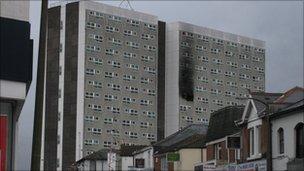Shirley Towers inquest: Deaths by misadventure verdict
- Published
The jury at the inquest into the deaths of two firefighters in a Southampton tower block has returned a verdict of death by misadventure.
The jury at the inquest into the deaths of two firefighters in a Southampton tower block has returned a verdict of death by misadventure.
Jim Shears, of Poole, Dorset, and Alan Bannon, of Southampton, died inside flat 72 of Shirley Towers in 2010.
The finding was delivered in conjunction with a narrative verdict which noted the pair died as a result of exposure to excessive heat.
The coroner said he would be making recommendations on safety improvement.
The verdict went on to record that operating conditions for all firefighters involved in tackling the fire became extremely difficult and dangerous and this significantly contributed to the deaths of the men.
Coroner Keith Wiseman said he would be making written recommendations in the coming weeks.
The inquest at Southampton Civic Centre has lasted four weeks.
During the hearing the court heard the fire on 6 April 2010, in a ninth-floor flat of the 15-storey block, started after a resident left a curtain resting on a lamp.
Karl Hoffman, who lived in the flat, told jurors he had tried to put out the fire with a cup of water and a bottle of soft drink before a neighbour dialled 999.
'Painful process'
Matt Wrack, general secretary of the Fire Brigades Union (FBU), said: "This has been a very difficult and painful process for the families, friends and colleagues of firefighters James Shears and Alan Bannon.
"Their loss is still very deeply felt by all those touched by their deaths.
"These dedicated firefighters died in the line of duty and the inquest played a key role in establishing the facts of what happened.

The fire started in a ninth-floor flat
"The biggest advances in firefighter safety have come from learning and applying the lessons of such tragedies.
"We owe a duty to all firefighters to learn those lessons, no matter how painful that process may be."
Mr Wrack said the inquest had established that previous recommendations stemming from the deaths of two firefighters and a member of the public in a tower block in Stevenage, Hertfordshire, in 2005 "had not been properly implemented".
He said the FBU and Hampshire Fire and Rescue Service had worked together to agree 10 key recommendations that would be raised with the fire minister.
Emergency delay
Mr Bannon and Mr Shears, known by the call-sign Red Two, were one of pair of two-man teams who were the first to arrive at the property.
The other two firefighters, Keith Holland and Liam Ryan - Red One - were soon beaten back by the increasing heat and escaped under "considerable physical distress", the court heard.
Jurors were also told it was about half an hour after Red Two had entered the flat before a "BA emergency" was declared - meaning the firefighters were in trouble.
Richard Hunt, of London Fire Brigade, who led the investigation, told the court the fire could have been put out sooner if different hose techniques had been used.
He also praised the crews' valiant efforts in trying to save their colleagues.
Father-of-two Mr Shears, 35, had been a firefighter for seven years.
Mr Bannon, 38, had been a fireman for eight-and-a-half years and had one child.
- Published10 July 2012
- Published27 June 2012
- Published26 June 2012
- Published22 June 2012
- Published22 June 2012
- Published19 June 2012
- Published18 June 2012